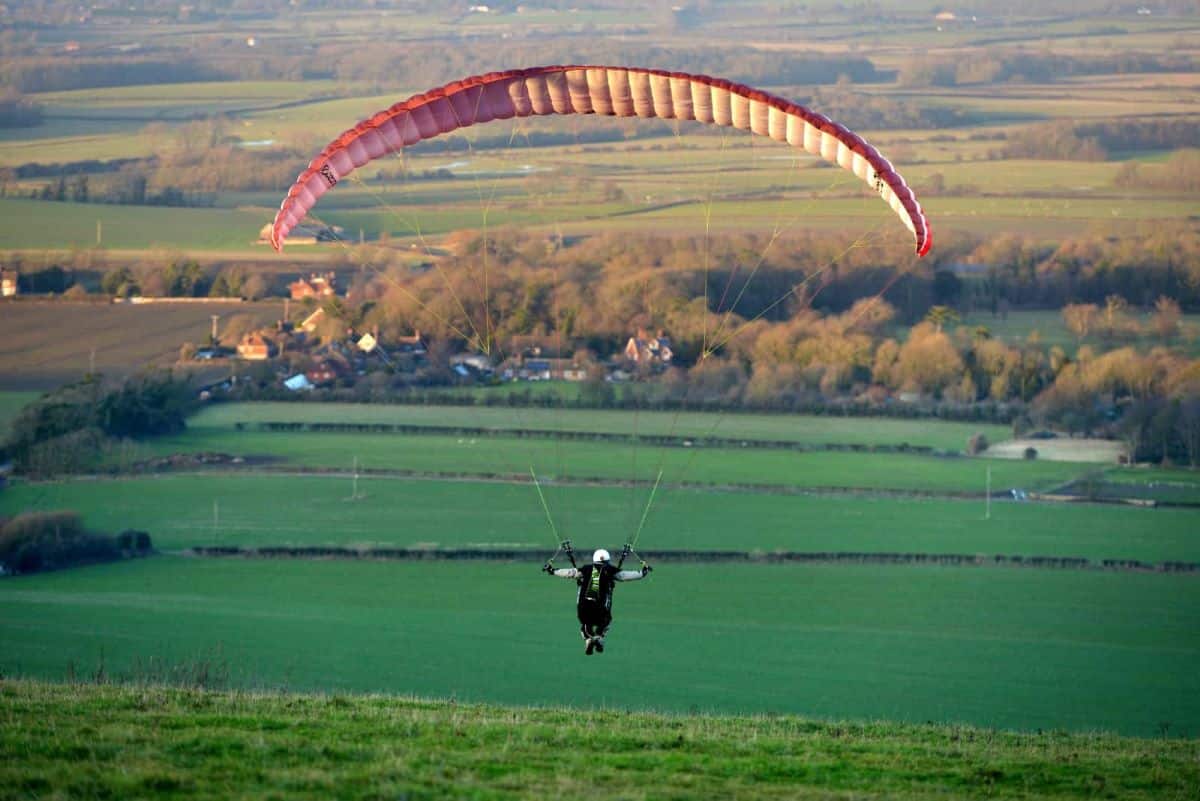The United Kingdom, a land steeped in history and natural beauty, is also a playground for adrenaline junkies and adventure enthusiasts. From the rugged cliffs of Scotland to the vast skies over England, the UK offers many activities designed to elevate your heart rate and deliver unforgettable thrills. This guide uncovers the ultimate bucket list for thrill-seekers, providing a comprehensive overview of each adrenaline-pumping activity, complete with insider tips, optimal travel times, and accessibility information. Whether you’re a seasoned adventurer or seeking to step outside your comfort zone, the UK’s diverse landscape awaits.
1. Skydiving in England

Skydiving in England offers an unparalleled opportunity to experience the thrill of free fall and breathtaking countryside views. Different drop zones cater to beginners and experienced skydivers, offering tandem jumps and AFF (Accelerated Free Fall) courses. One notable location is the Skydive Hibaldstow in North Lincolnshire, boasting the highest skydive in the UK at up to 15,000 feet. Participants enjoy a minute of free fall, reaching speeds of up to 120 mph, before the parachute deployment offers a serene descent, revealing stunning vistas of the surrounding area.
Insider’s Tip: Opt for a morning jump to enjoy clearer skies and less turbulence.
When to Travel: Skydiving season runs from March to October, with the best conditions typically in late spring to early autumn.
How to Get There: Skydive Hibaldstow is accessible by car via the A15 or by train to Barnetby station, followed by a short taxi ride.
2. White-Water Rafting in Scotland

Scotland’s rugged terrain and abundant waterways make it an ideal destination for white-water rafting. The River Tay in Perthshire offers experiences ranging from family-friendly excursions to challenging rapids for the more experienced. At 120 miles, it’s Scotland’s longest river, providing diverse conditions suitable for all skill levels. Rafting trips on the Tay combine thrilling rapids with the chance to admire the stunning Scottish landscape from a unique perspective.
Insider’s Tip: Book a trip after a period of rainfall for the most exhilarating rapids.
When to Travel: The rafting season extends from May to October, with peak flows often in early spring and after summer rains.
How to Get There: The River Tay is best accessed from Perth, which is well-connected by train and bus services from major Scottish cities.
3. Coasteering in Wales

Coasteering in Wales is an exhilarating blend of rock climbing, cliff jumping, and swimming along the rugged Welsh coastline. With its dramatic cliffs and crystal-clear waters, Pembrokeshire is a premier destination for this adventure sport. Participants navigate the intertidal zone, exploring sea caves, rock pools, and natural rapids, all under the guidance of experienced instructors. This activity pumps adrenaline and offers an intimate encounter with the marine environment and wildlife.
Insider’s Tip: Wear sturdy, closed-toe shoes with good grip for the rocky sections.
When to Travel: The best months for coasteering are from May to September, when the water temperatures are more comfortable.
How to Get There: Pembrokeshire is accessible by train to Haverfordwest, followed by a bus or taxi to the coast.
4. Mountain Biking in the Lake District

The Lake District National Park is the ultimate destination for mountain bikers, with trails ranging from gentle lakeside paths to challenging mountain terrains. Whinlatter Forest and Grizedale Forest are particularly notable, offering purpose-built trails with breathtaking views of the surrounding fells and lakes. These locations provide options for all levels, including adrenaline-fueled downhill tracks and technical singletrack, ensuring an unforgettable ride through some of the UK’s most scenic landscapes.
Insider’s Tip: Check trail conditions and closures on the park’s website before your visit, especially after adverse weather.
When to Travel: Spring through autumn offers the best riding conditions, with drier trails and longer daylight hours.
How to Get There: The Lake District is best accessed by car. Public transport options include trains to Windermere, Penrith, or Keswick, with local bus services to the forests.
5. Bungee Jumping in Scotland

For those seeking a pure adrenaline rush, bungee jumping in Scotland presents a thrilling leap into the air. The Highland Fling Bungee Jump, located near Pitlochry in Perthshire, allows participants to experience a 40-meter free fall towards the River Garry. Set within a dramatic gorge, this jump is about the thrill and the stunning natural backdrop. Safety is paramount, with experienced instructors ensuring a secure and exhilarating experience.
Insider’s Tip: Opt for the night jump, which is available on select dates for an added thrill.
When to Travel: Bungee jumping is available year-round, but spring to autumn offers more favourable weather conditions.
How to Get There: Pitlochry is accessible by train from Edinburgh or Glasgow, followed by a short taxi ride to the jump site.
6. Surfing in Cornwall

Cornwall is the UK’s surfing capital, boasting consistent waves and beautiful beaches. Newquay, in particular, is renowned for its vibrant surfing scene and hosts several international competitions. Fistral Beach and Watergate Bay offer excellent conditions for beginners and advanced surfers. Surf schools dot the coastline, providing lessons and equipment hire. Beyond the thrill of riding the waves, surfing in Cornwall is an opportunity to immerse oneself in the local surf culture and enjoy the stunning coastal scenery.
Insider’s Tip: Early morning and late afternoon sessions often offer the best combination of tide, wind, and fewer crowds.
When to Travel: The surfing season peaks from late summer to early winter, with the biggest swells typically in autumn.
How to Get There: Newquay is accessible by train, with Newquay Airport offering flights from major UK cities.
7. Paragliding in the South Downs

The South Downs National Park offers a serene yet exhilarating paragliding experience, with rolling hills providing the perfect launch sites for beginners and seasoned pilots alike. The park’s upland areas catch the prevailing winds, creating ideal conditions for flight. Schools in the area offer tandem flights and courses, allowing participants to soar above the picturesque landscape, with views stretching to the English Channel. The sense of freedom and tranquillity experienced while gliding through the air is unmatched.
Insider’s Tip: Opt for a late afternoon flight for stable thermal conditions and the chance to witness a stunning sunset from the air.
When to Travel: Paragliding is best from April to September, with the most stable weather conditions.
How to Get There: The South Downs are easily reached by train to Brighton or Lewes, with local transport options to the flying sites.
8. Cave Diving in the Scottish Highlands

The Scottish Highlands, with their mysterious lochs and ancient caves, offer a unique setting for cave diving. This niche but growing sport combines scuba diving with caving, allowing adventurers to explore submerged cave systems. The clear waters of the Highlands’ caves present a surreal underwater world of rock formations and marine life, untouched by the surface world. Cave diving in Scotland requires high skill and certification due to the challenging conditions and cold water temperatures. However, it’s an unparalleled opportunity for those qualified to venture into the unknown and experience the thrill of exploration in complete silence beneath the earth’s surface.
Insider’s Tip: Ensure you have the appropriate cave diving certification and are accompanied by an experienced guide familiar with the specific cave system.
When to Travel: Summer months, from June to August, offer the most favourable conditions for cave diving in Scotland, with longer daylight hours and slightly warmer water temperatures.
How to Get There: The Scottish Highlands are best accessed by car to reach the remote diving locations. The nearest major airports are Inverness and Glasgow, from where you can hire a car. Local dive centres offer guided tours and equipment rental.
The Bottom Line

For those seeking to elevate their travel experiences with adrenaline-pumping activities, the UK offers a diverse playground catering to every thrill-seeker. From the vertical cliffs of Pembrokeshire to the Scottish Highlands’ submerged caves, each adventure challenges your limits and immerses you in the UK’s stunning natural landscapes. Remember, these activities offer the chance to step out of your comfort zone and into the extraordinary. Whether you’re scaling rock faces, biking through ancient woodlands, or diving into hidden underwater worlds, the UK’s array of thrilling experiences is sure to leave a lasting impression. Always prioritize safety by choosing reputable guides and operators, and consider the environmental impact of your adventures.
Featured Image Credit: Shutterstock / Peter Cripps.
The content of this article is for informational purposes only and does not constitute or replace professional advice.
The images used are for illustrative purposes only and may not represent the actual people or places mentioned in the article.
For transparency, this content was partly developed with AI assistance and carefully curated by an experienced editor to be informative and ensure accuracy.

